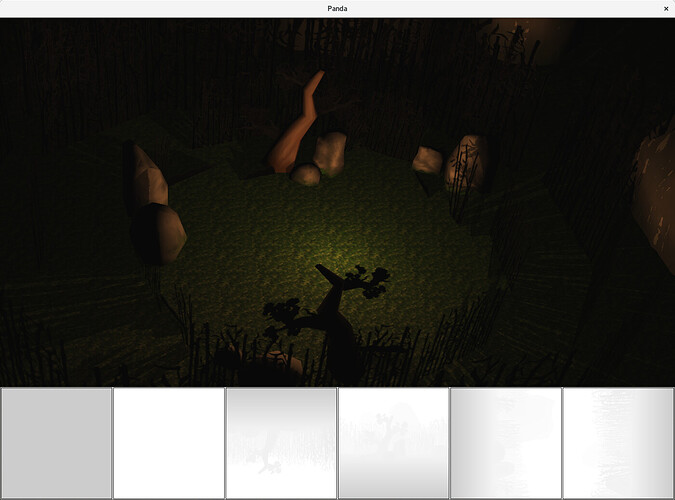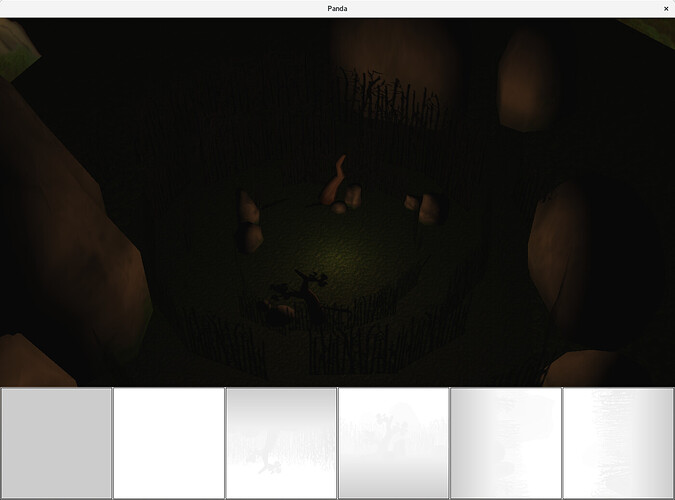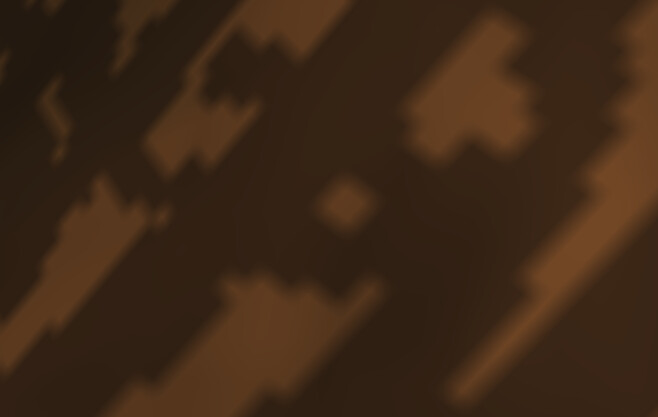Sorry it took me half a year to reply, I was focusing on other parts of the project.
I tried putting together a minimal example. However, I can no longer reproduce the error I got above, and I don’t know why - maybe some graphic driver update fixed it?
Still, I cannot get the samplerCubeShadow to work. I get “zeros” everywhere in the texture lookup (i.e. no samples pass the depth comparison) but when switching back to samplerCube, everything works as expected. The only thing I changed was a line in the two definitions of p3d_LightSourceParameters and the texture lookup in calcShadow.
I do not get any errors, and I tried different glsl versions…
This sample should be self-contained (save as main.py and run python3 main.py).
Any help appreciated!
What I get with samplerCube:
And with samplerCubeShadow:
Note that the render buffers are almost the same in both cases (press “v” to enable).
from direct.showbase.ShowBase import ShowBase
from panda3d.core import PointLight, AmbientLight
from panda3d.core import Vec4
from panda3d.core import Shader
from direct.showbase.BufferViewer import BufferViewer
# Shaders adapted from examples by @wezu:
# https://discourse.panda3d.org/t/shadows-made-easy/15399
v_shader='''
#version 330
uniform struct p3d_LightSourceParameters {
// Primary light color.
vec4 color;
// Light color broken up into components, for compatibility with legacy
// shaders. These are now deprecated.
vec4 ambient;
vec4 diffuse;
vec4 specular;
// View-space position. If w=0, this is a directional light, with the xyz
// being -direction.
vec4 position;
// Spotlight-only settings
vec3 spotDirection;
float spotExponent;
float spotCutoff;
float spotCosCutoff;
// Individual attenuation constants
float constantAttenuation;
float linearAttenuation;
float quadraticAttenuation;
// constant, linear, quadratic attenuation in one vector
vec3 attenuation;
// Shadow map for this light source
// ENABLE FOR HARD SHADOWS:
//samplerCube shadowMap;
// ENABLE FOR SOFT SHADOWS:
samplerCubeShadow shadowMap;
// Transforms view-space coordinates to shadow map coordinates
mat4 shadowViewMatrix;
} p3d_LightSource[1];
uniform mat4 p3d_ModelViewProjectionMatrix;
uniform mat3 p3d_NormalMatrix;
uniform mat4 p3d_ModelViewMatrix;
in vec4 p3d_Vertex;
in vec3 p3d_Normal;
in vec2 p3d_MultiTexCoord0;
out vec2 uv;
out vec4 shadow_uv;
out vec3 normal;
out vec3 vertex_viewspace;
out vec3 normal_viewspace;
void main()
{
//position
gl_Position = p3d_ModelViewProjectionMatrix * p3d_Vertex;
//normal
normal = p3d_NormalMatrix * p3d_Normal;
//uv
uv = p3d_MultiTexCoord0;
normal_viewspace = normalize( p3d_NormalMatrix * p3d_Normal );
vertex_viewspace = vec3(p3d_ModelViewMatrix * p3d_Vertex);
//shadows
//shadow_uv = p3d_LightSource[0].shadowViewMatrix * p3d_Vertex;
shadow_uv = p3d_LightSource[0].shadowViewMatrix * vec4(vertex_viewspace, 1);
//shadow_uv = p3d_LightSource[0].shadowViewMatrix * (p3d_ModelViewMatrix * p3d_Vertex);
}
'''
#fragment shader
f_shader='''
#version 330
uniform sampler2D p3d_Texture0;
uniform vec3 camera_pos;
uniform float shadow_blur;
in vec2 uv;
in vec4 shadow_uv;
in vec3 normal;
in vec3 vertex_viewspace;
in vec3 normal_viewspace;
out vec4 out_color;
float NEAR = 1;
float FAR = 500;
in vec4 shadow_coords;
uniform struct p3d_LightSourceParameters {
// Primary light color.
vec4 color;
// Light color broken up into components, for compatibility with legacy
// shaders. These are now deprecated.
vec4 ambient;
vec4 diffuse;
vec4 specular;
// View-space position. If w=0, this is a directional light, with the xyz
// being -direction.
vec4 position;
// Spotlight-only settings
vec3 spotDirection;
float spotExponent;
float spotCutoff;
float spotCosCutoff;
// Individual attenuation constants
float constantAttenuation;
float linearAttenuation;
float quadraticAttenuation;
// constant, linear, quadratic attenuation in one vector
vec3 attenuation;
// Shadow map for this light source
// ENABLE FOR HARD SHADOWS:
//samplerCube shadowMap;
// ENABLE FOR SOFT SHADOWS:
samplerCubeShadow shadowMap;
// Transforms view-space coordinates to shadow map coordinates
mat4 shadowViewMatrix;
} p3d_LightSource[1];
float hardShadow(samplerCube tex, vec3 uv, float bias, float depth)
{
float closestDepth = texture(tex, uv).r;
float shadow = 0.0;
if(depth - bias < closestDepth)
shadow += 1.0;
return shadow;
}
float calcShadow( vec4 shadow_coords )
{
vec4 coords;
coords.xyz = shadow_coords.xyz / shadow_coords.w;
float dist = max(abs(coords.x), max(abs(coords.y), abs(coords.z)));
coords.w = (NEAR + FAR) / (FAR - NEAR) + ((-2 * FAR * NEAR) / (dist * (FAR - NEAR)));
coords.w = coords.w * 0.5 + 0.5;
// ENABLE FOR HARD SHADOWS:
//float shadow = hardShadow( p3d_LightSource[0].shadowMap, coords.xyz, 1e-4, coords.w );
// ENABLE FOR SOFT SHADOWS:
float shadow = texture( p3d_LightSource[0].shadowMap, coords );
return shadow;
}
void main()
{
//base color
vec3 ambient=vec3(0.03, 0.03, 0.03);
//texture
vec4 tex=texture(p3d_Texture0, uv);
//light ..sort of, not important
vec3 light=p3d_LightSource[0].color.rgb*max(dot(normalize(normal),-p3d_LightSource[0].spotDirection), 0.0);
vec3 diffuseCol = tex.rgb;
float shininess = 1;
vec3 color = vec3(0,0,0);
vec3 diff = p3d_LightSource[0].position.xyz - vertex_viewspace * p3d_LightSource[0].position.w;
vec3 L = normalize(diff);
vec3 E = normalize(-vertex_viewspace);
vec3 R = normalize(-reflect(L, normal_viewspace));
float diffusePower = max(dot(normal_viewspace, L), 0) * 0.5;
float specularPower = pow(diffuseCol.r*max(dot(R, E), 0), shininess);
float len = length(diff);
float attenuation = 1 / dot(p3d_LightSource[0].attenuation, vec3(1, len, len*len));
float specular = 0.1;
color += diffuseCol.rgb * p3d_LightSource[0].color.rgb * diffusePower * attenuation;
color += p3d_LightSource[0].color.rgb * specularPower * specular * attenuation;
// calculate shadow
float shadow = calcShadow( shadow_uv );
//make the shadow brighter
shadow=0.5+shadow*0.5;
//out_color=vec4(shadow,shadow,shadow,1);//, tex.a);
out_color = vec4(ambient+color*shadow, tex.a);
}'''
class MyApp(ShowBase):
def __init__(self):
ShowBase.__init__(self)
# Load the environment model.
self.scene = self.loader.loadModel("environment.egg")
# Reparent the model to render.
self.scene.reparentTo(self.render)
# Apply scale and position transforms on the model.
self.scene.setScale(0.25, 0.25, 0.25)
self.scene.setPos(-8, 42, 0)
# Set up point light that will cast shadows:
plight = PointLight('plight')
plight.setColorTemperature( 3600 )
plight.setShadowCaster(True, 1024, 1024)
plnp = render.attachNewNode(plight)
plnp.setPos(0, 0, 5)
render.setLight(plnp)
for i in range(6):
plight.getLens(i).setNear(1)
plight.getLens(i).setFar(500)
# Let environment receive shadows:
self.init_shaders()
self.accept("v", base.bufferViewer.toggleEnable)
def init_shaders(self):
shader = Shader.make(Shader.SL_GLSL, v_shader, f_shader)
self.scene.setShader(shader)
self.scene.set_two_sided(True)
#self.scene.ls()
app = MyApp()
app.run()


